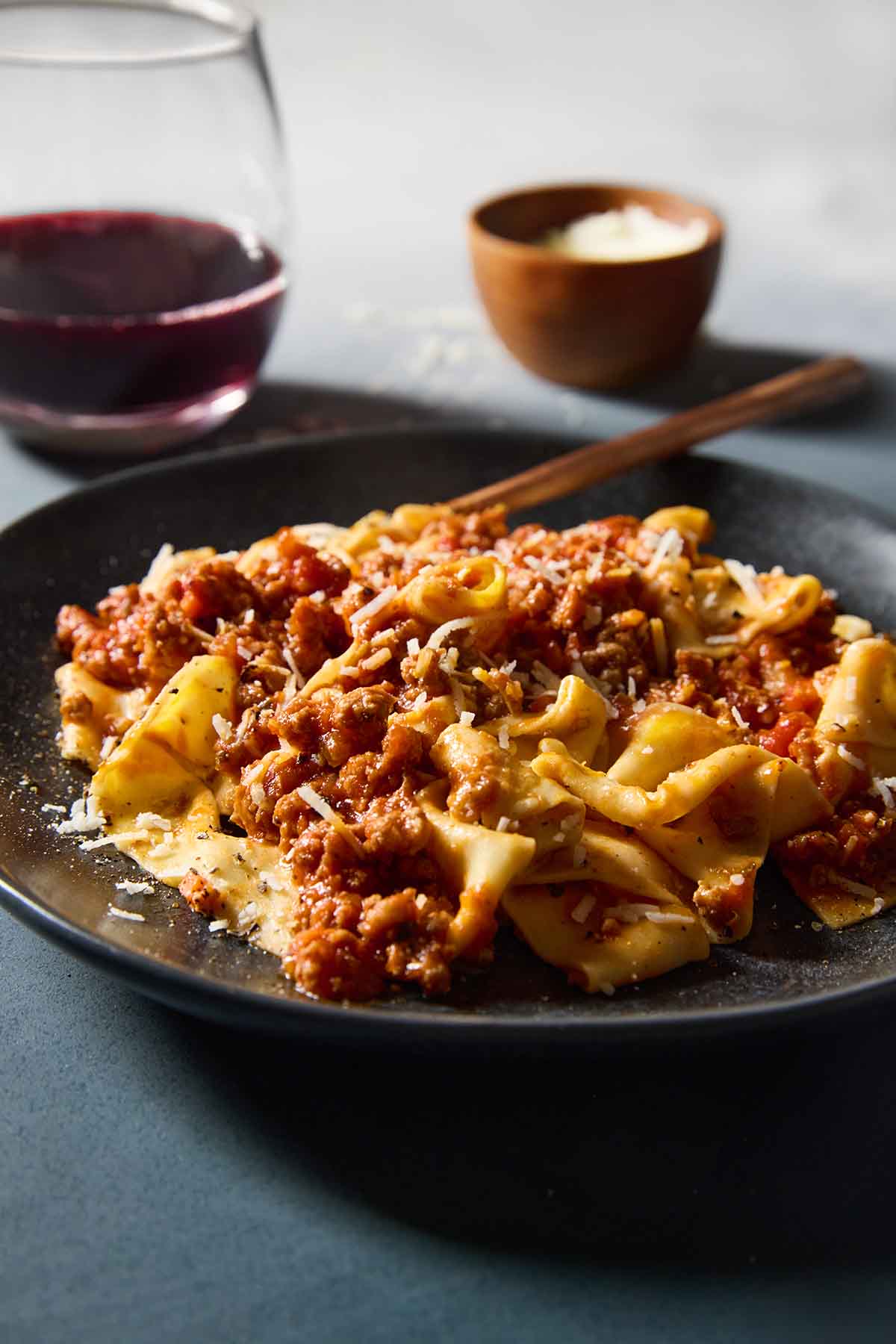
In her first cookbook, The Classic Italian Cookbook, Marcella Hazan offers the home cook an authentic Bolognese sauce recipe. The recipe calls for chuck and/or beef necks—the traditional kind an Italian grandmother would approve of, thank you very much.
This is my version of her recipe, with some tweaks. I’ve added veal and pork to the beef, and I’ve doubled her recipe, as we could never get enough!
Yes, it does take a while to make, although most of the time, the Bolognese gently simmers unattended on the back burner, except for occasionally making lazy eights with a wooden spoon.
Chow,

Jump To

Why You Can Trust This Recipe
Marcella’s bodacious Bolognese is all about concentration–of flavors and texture–which it gets through low and slow cooking. First, there’s the milk. Its calcium and acidity help tenderize the beef while contributing to a creamy texture.
Then, while the sauce burbles, collagen breaks down, creating a marvelously velvety consistency. Along the way, the milk and wine evaporate, concentrating the favors.
The San Marzano tomatoes cook down during the long cooking, lending balanced sweetness and acidity. That last knob of butter enriches and emulsifies the sauce. About the only concentration not going on here is yours–this is pretty much a set-it-and-forget-it sauce.
Notes on Ingredients
- Ground chuck–You can use all beef or a combination of veal and beef. The more marbled the meat, the sweeter the ragu. (The most desirable cut of meat is the neck portion of the chuck. You may have to put a special order for it from your butcher.)
- Milk–The enzymes in milk help to soften the proteins in the meat to make it more tender. Don’t be tempted to use low-fat milk; the added fat in whole milk adds a welcome layer of richness to the sauce.
- White wine–Stick with a dry white here, such as Sauvignon Blanc or Pinot Grigio. Avoid sweet wines, as they’ll change the flavor of the sauce.
- Parmesan cheese–Use the imported stuff (Parmigiano-Reggiano). It makes a world of difference.
How to Make Bolognese Sauce
- Heat the oil and 6 tablespoons of the butter in a large, heavy-bottom Dutch oven until the butter is melted and stops foaming.
- Add the onion and sauté until softened.
- Stir in the celery and carrot and cook for 2 minutes.
- Add the meat and season with salt. Cook, stirring occasionally, until the meat is no longer raw.
- Pour in the milk and simmer over low heat until evaporated.
- Add the nutmeg and wine and continue to simmer until the wine has evaporated.
- Stir in the crushed tomatoes and simmer gently, stirring occasionally, until the fat separates from the sauce.
- Season to taste and serve with cooked drained pasta and freshly grated Parmigiano-Reggiano.
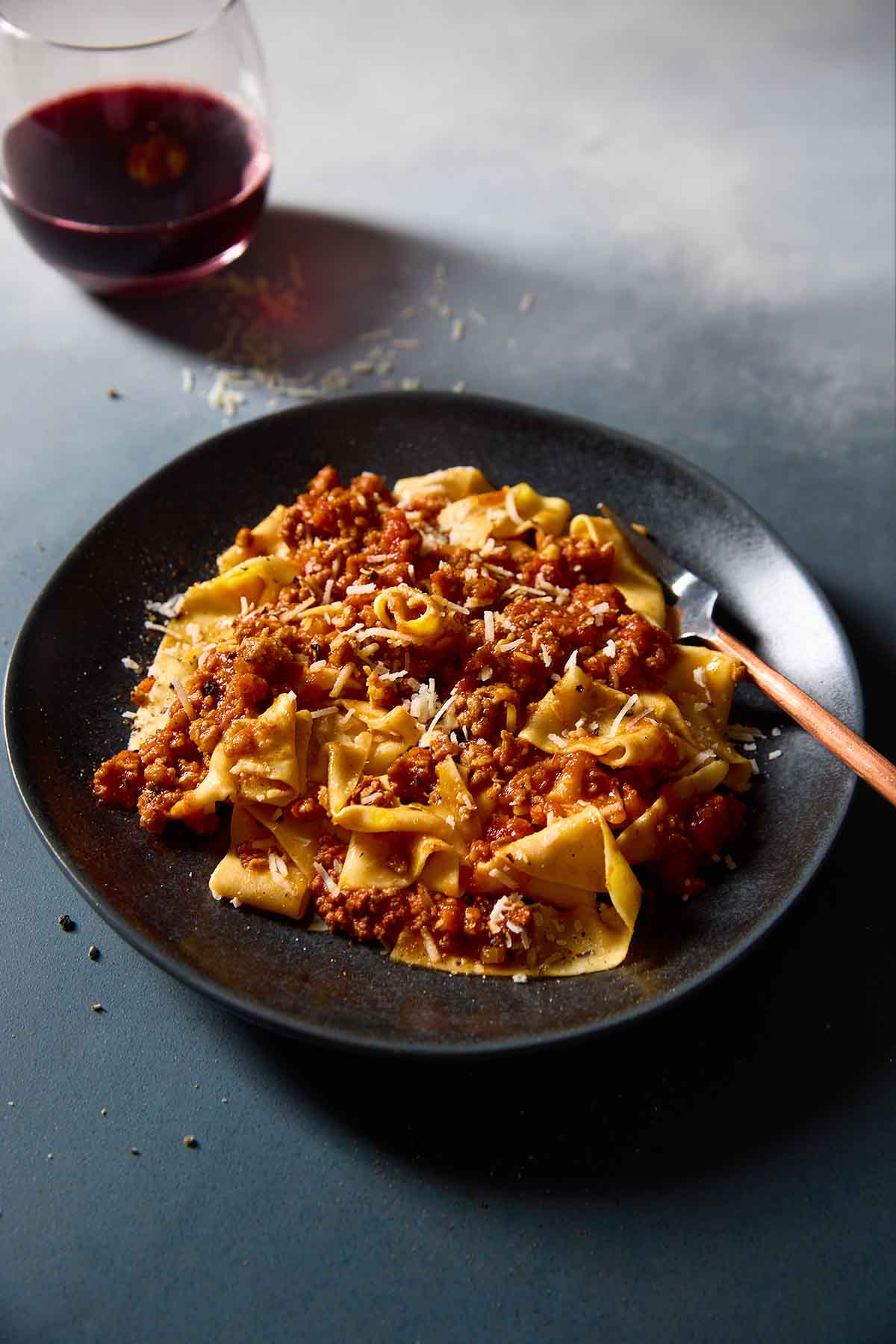
Common Questions
In essence, Bolognese sauce is spaghetti sauce. Though it’s no ordinary meat sauce. It’s a long, slowly simmered sauce that’s richer and creamier than your everyday marinara due to the inclusion of milk. It also is less predominated by tomatoes than your typical marinara. It’s named for its city of origin, Bologna.
Believe it or not, traditional Bolognese contains none of the aromatic herbs or spices that many consider necessary in all Italian dishes. You may be tempted to add them, but do your best to resist. The nutmeg is a must—don’t leave that out.
Storage & Reheating
Let your sauce cool completely before storing it in an airtight container in the refrigerator for up to 4 days. Bolognese sauce can be frozen in zip-top bags or freezer-safe containers for up to 3 months. Thaw it in the refrigerator overnight before using.
To reheat your sauce, place it in a large saucepan over low heat and warm gently, stirring occasionally.
Pro Tips
- Avoid lean cuts of beef at all costs. The more marbled it is, the sweeter the ragù will be. If you can get it, Marcella’s prized cut for this is the neck portion of the chuck.
- It’s important to season the meat with a large pinch of salt as soon as it hits the pan. This draws out the juices and imparts flavor to the Bolognese.
- Cook the meat in milk before adding the wine and tomatoes to protect it from the acidic bite of the latter.
- Use a heavy pot that will retain heat. I use my Le Creuset 5-quart Dutch oven. Avoid using cast iron, as the acid can interact with the metal and turn the sauce a blech color.
- Cook, uncovered, at the merest simmer for a long, long time. Because this is a double batch, no less than 6 hours is necessary.
What to Serve with This Recipe
Marcella recommends serving her Bolognese sauce with tagliatelle, but if you prefer spaghetti Bolognese, you can do that or even layer the sauce between sheets of pasta to create a lasagne Bolognese. Round out your meal with an easy Italian salad and a loaf of crusty bread.
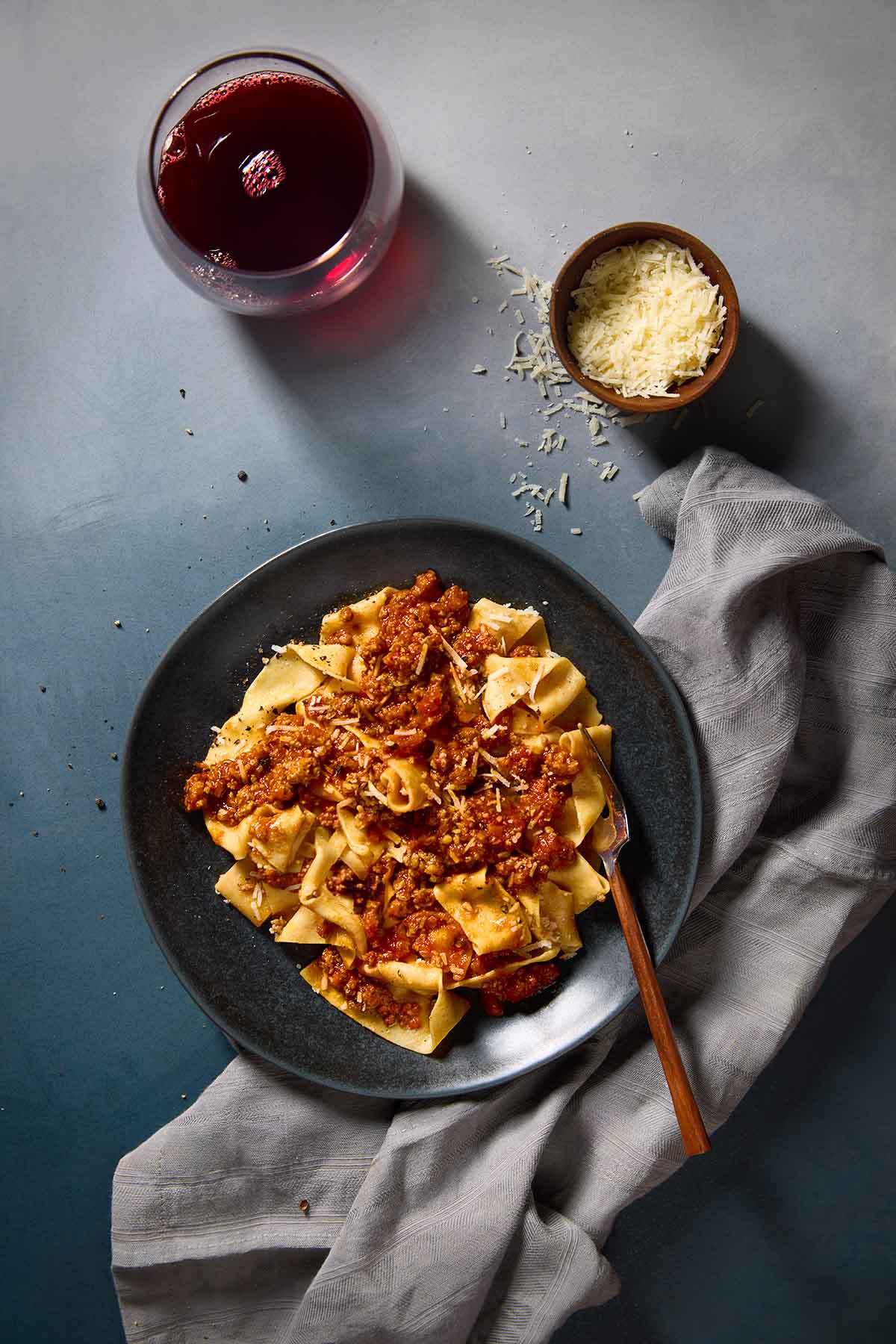
Write a Review
If you make this recipe, or any dish on LC, consider leaving a review, a star rating, and your best photo in the comments below. I love hearing from you.–David
I’ve been using recipes on Leite’s Culinaria for years and the bolognese recipe inspired by Marcella Hazan is among my favorites. Thank you, David, and team for all you do!
Jeff McWilliam
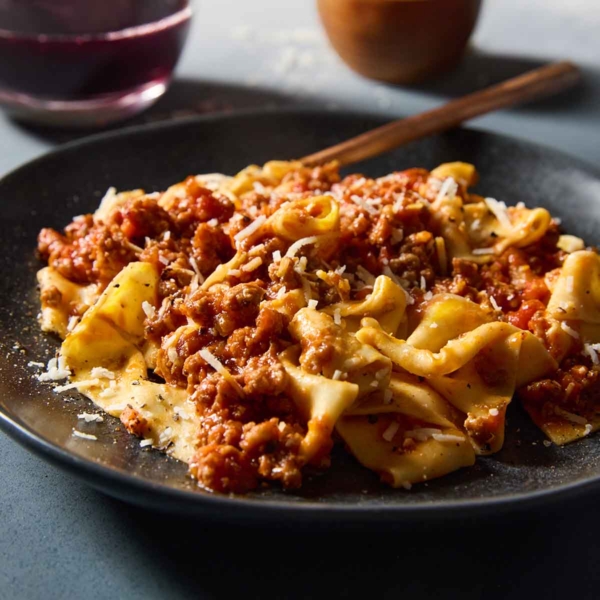
Marcella Hazan’s Bolognese Sauce
Ingredients
- 2 tablespoons vegetable oil
- 8 tablespoons (4 oz) unsalted butter, divided
- 1 cup chopped onion
- 1 1/3 cups chopped celery
- 1 1/3 cups chopped carrot
- 1 pound ground chuck, (I used 1/2 pound chuck and 1/2 pound veal)
- 1/2 pound ground pork
- kosher salt and freshly ground black pepper
- 2 cups whole milk
- 1/8 teaspoon freshly grated nutmeg, or a pinch of ground nutmeg
- 2 cups dry white wine
- 3 cups canned imported San Marzano tomatoes, (Italian plum tomatoes) with their juice
- 1 pound tagliatelle, (homemade or storebought), cooked and drained
- freshly grated Parmigiano-Reggiano cheese, at the table
Instructions
- Warm the 2 tablespoons vegetable oil and 6 tablespoons of the butter in a heavy 5-quart Dutch oven over medium heat until the butter melts and stops foaming. Toss in the 1 cup chopped onion and cook, stirring frequently, until the onion is softened and translucent, about 5 minutes.
- Toss in the 1 1/3 cups chopped celery and 1 1/3 cups chopped carrot and cook, stirring to coat them with the oil and butter, for 2 minutes.
- Add the 1 pound ground chuck (and veal if using) and 1/2 pound ground pork, a very healthy pinch of kosher salt and freshly ground black pepper. Crumble the meat with a wooden spoon and cook, stirring occasionally, until the meats have just lost their raw-red color.
☞ TESTER TIP: If there's a lot of fat in the bottom of the pan due to the pork, you can spoon some out before adding the milk.
- Reduce the heat to low. Pour in the 2 cups whole milk and simmer gently, stirring frequently, until the liquid has completely evaporated, about 1 hour.
- Stir in the 1/8 teaspoon freshly grated nutmeg. Pour in the 2 cups dry white wine and gently simmer, stirring frequently, until it's evaporated, about 1 1/4 hours more.
- Add the 3 cups canned imported San Marzano tomatoes and stir well. When the sauce begins to bubble, turn down the heat so that the sauce cooks at the laziest of simmers with just an intermittent bubble breaking the surface.
- Cook, uncovered, for 3 hours or more, stirring from time to time. While the sauce is burbling away, there's a chance that it'll start drying out. To keep the sauce from sticking to the bottom of the pot and scorching, add 1/2 cup water if necessary, just know that it's crucial that by the time the sauce has finished simmering, the water should be completely evaporated, and the fat should separate from the sauce.
- Taste a spoonful—or two—of sauce and season with salt and some good grindings of pepper to taste. Add the remaining 2 tablespoons butter to the cooked, hot pasta and toss with the sauce. Serve with freshly grated Parmigiano-Reggiano cheese on the side.
Notes
What You Need To Know About Making The Most Classic Italian Bolognese
- The more marbled the meat, the sweeter the ragu. (The most desirable cut of meat is the neck portion of the chuck. You may have to special order it from your butcher.)
- In Marcella’s original recipe, she calls for only ground chuck. Over the years, I’ve added veal and pork to the recipe. You can opt for a full-beef version.
- It’s important to salt the meat as soon as it hits the pan. This draws out the juices and imparts flavor to the Bolognese.
- Use a heavy pot that will retain heat. I use my Le Creuset 5-quart Dutch oven. Avoid using cast-iron, as the acid can interact with the metal and turn the sauce a blech color.

Nutrition
Nutrition information is automatically calculated, so should only be used as an approximation.
Recipe Testers’ Reviews
This is the perfect Italian Bolognese to make if you’re stuck in the house doing chores and can’t leave. A little prep work and a little stir every now and then give you a wonderful smell throughout your house and a nice, thick sauce for your pasta.
Unlike most commercial jar sauces, this sauce doesn’t have a strong tomato taste. I love that. It is pure, hearty, stick-to-your-ribs comfort food.
All you need is some warm bread, and you have a meal. The next time I make it, I’ll probably omit the oil, as I felt there was a little too much oil floating on top when it was ready to serve.
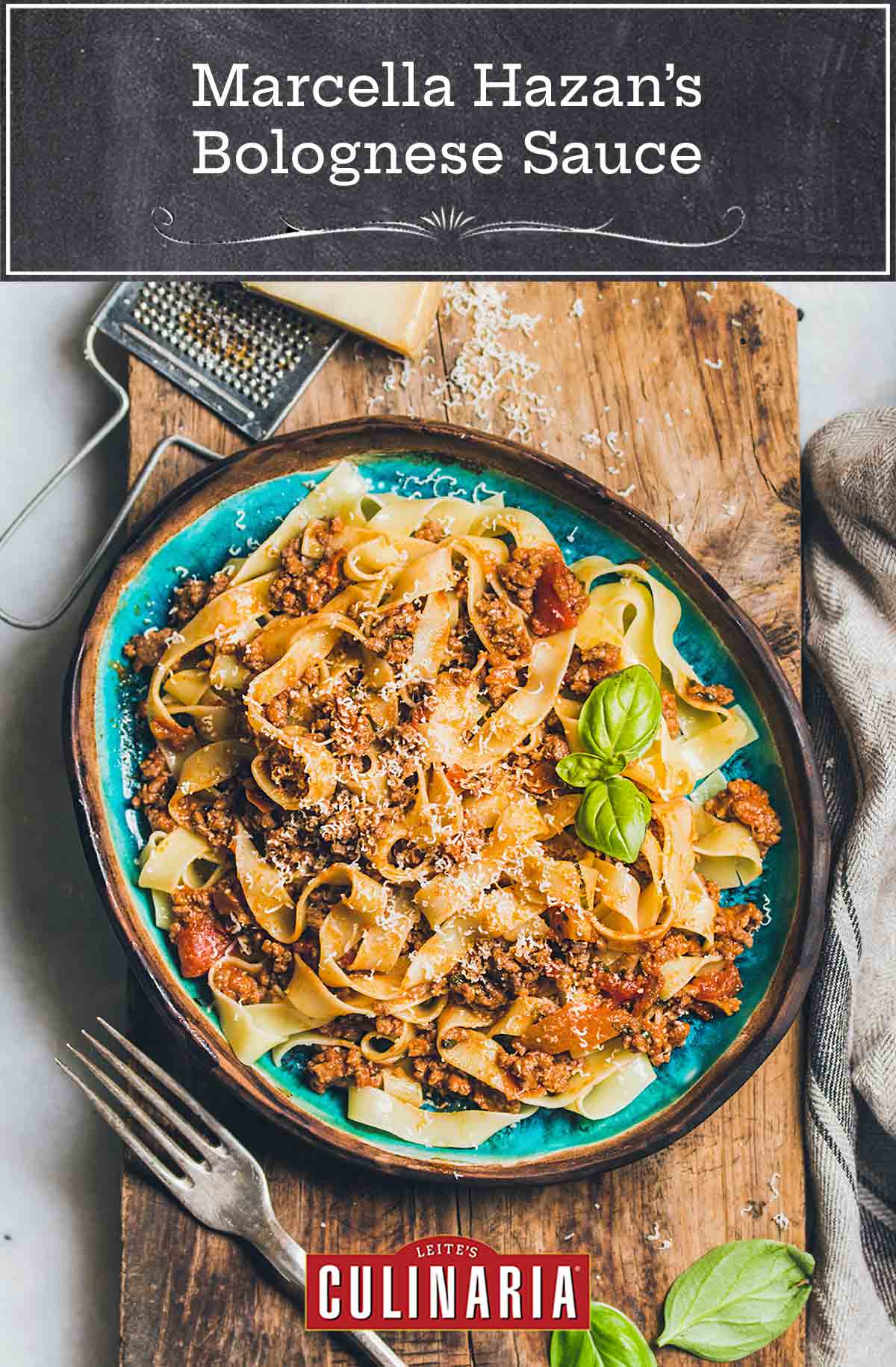
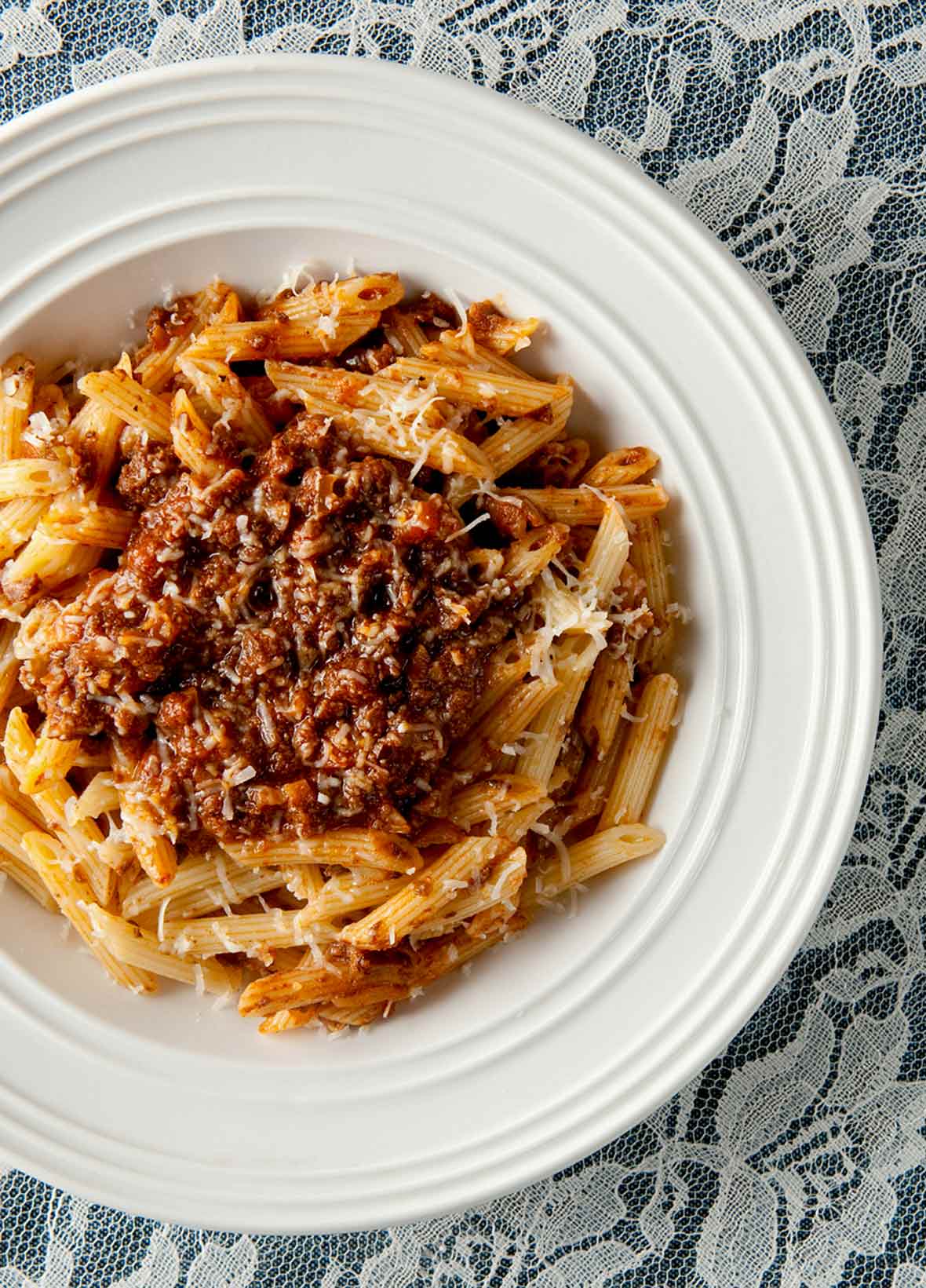
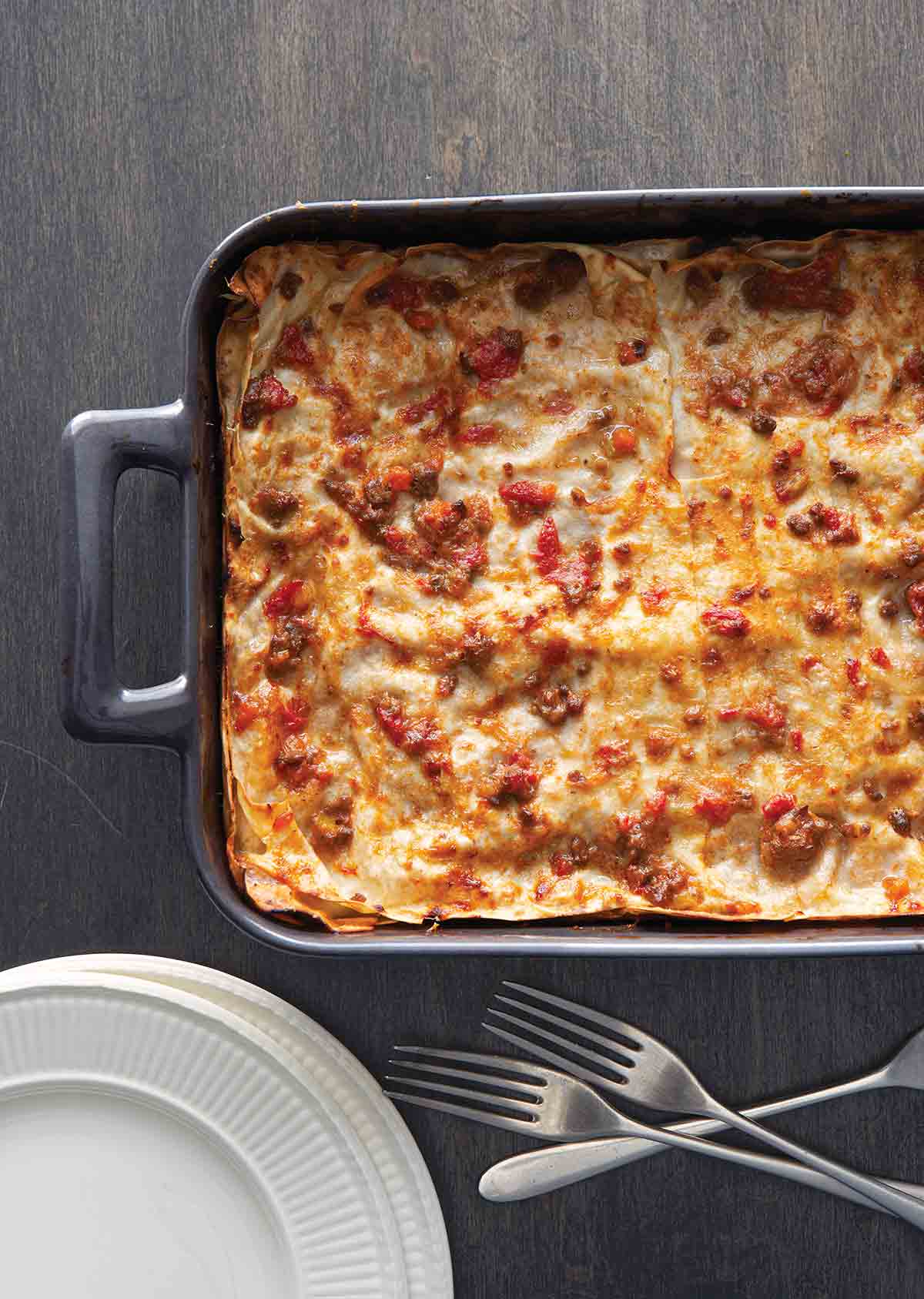










This is a fabulous recipe, which I’ve made a few dozen times both at home and in restaurants where I’ve worked. The only change I’ve ever incorporated is the addition of some chicken livers, which I mince so that my children don’t know that liver is part of the whole. Try it some time.
Mark, yes, chicken livers are a favorite addition, some say it’s the classic recipe. If I remember to pick them up, I add them. Gives some nice bass notes.
Hi David,
I would like to try adding chicken livers to this incredible recipe. At what point would you recommend adding the chicken livers?
Hey, Mark. Some people add them early in the cooking, but I think the flavor gets lost. I would add them the last 20 minutes of cooking. Roughly chop them, toss them in, and stir until they cook through and break down. That way you’ll still get a wonderful flavor.
I don’t have Ms. Hazan’s cookbook but I’ve been making this recipe for a few years. I’m always flummoxed by the lack of any mention of draining fat. I end up with so much fat it’s downright unappetizing, so I drain all but the smallest bit. It’s quite delicious that way, but I wonder if I’m doing my sauce a disservice by draining. What do others do?
Sarah, no, you’re not doing a disservice at all. I do wonder: What’s the fat ratio of your beef? And are you using all the butter in the sauce or half in the sauce and half for the pasta?
Thank you for sharing this recipe. I am one to improvise on recipes or forget steps, but in honor of Marcella, I followed the recipe to a “T” and didn’t add anything extra. It came out amazing. The recipe takes time but is simple in technique, and it taught me how much of a difference time can make. In my improvisational cooking style, I never put too much thought into time and layering flavors. Not only is this a recipe I’ll keep forever, but the skeleton of the recipe will help me cook more thoughtfully.
Tara, then Marcella (and I guess me, in the smallest of ways) have done our jobs. Now, you can go on to show others the benefit and pleasure of slow, layered cooking!
“But it’s crucial that by the time the sauce has finished simmering, the water should be completely evaporated,”
I’m confused by the sentence I’ve copied above. First of all, it can’t possibly be accurate; if all the water evaporates, the sauce is becomes a mixture of powder and rock-hard chunks of former food.
What I assume it means is that if I draw a spoon through the middle of the sauce, it stays parted like Moses did to the Red Sea.
When I made this sauce in this way, I found the end result inedible. In the dozen or two experiments that I’ve run since then, I discovered that when the sauce is too dry, some of the flavors become very harsh. It makes sense, because some flavors are water soluble, and without enough water, you won’t be able to taste them.
However, the above picture looks pretty dry to me and I’m not sure why that hasn’t worked for me.
Greg, it definitely means what it says: that the water evaporates. And it won’t be a mixture of powder and rock-hard chunks because there is fat in it, as well as moisture in the meat, tomatoes, etc. Basically, make sure that the added water evaporates, and only the added water. Hope this helps.
David, thanks for replying. Afraid it doesn’t help, though….you’d have to reach through the screen and taste what I’d made. As I said, my batch of Hazan’s Bolognese was inedible. Had to throw it away. It tasted…vegetably (is that a word?). I’m not sure if this is something I’m doing wrong, or I don’t know what this sort of Bolognese is supposed to taste like. Other recipes seem more liquid….”The Splendid Table” says consistency of thick soup, which is a lot thinner than Hazan’s Bolognese, or so it seems to me.
I probably suffer from not ever eaten a true Bolognese, so I don’t know what all the fuss is about. I’ve never actually seen it on any of the menus of the Italian restaurants in my city, and I’m not sure it would be an accurate rendition if I did.
Road trip! Where is the best Bolognese that you’ve ever eaten?
Greg, I’m at a loss. Send me an email at david@leitesculinaria.com, and perhaps we can set up a call or a Skype conversation, so I can see what you’re doing.